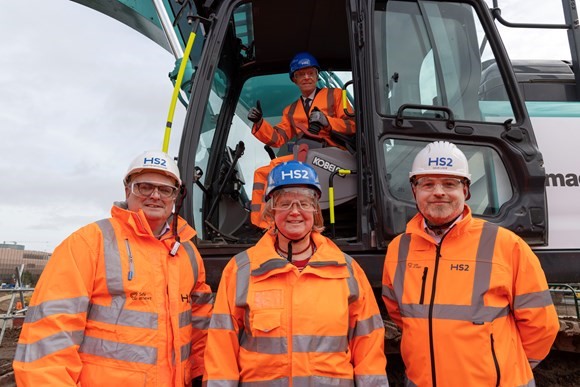Yesterday HS2 marked the start of construction on the landmark Birmingham Curzon Street Station – a new rail hub that will play a vital role in the long-term economic future of the West Midlands. Birmingham Curzon Street Station, which will be net zero carbon in operation, will be the first brand new intercity terminus station built in Britain since the 19th Century. HS2’s contractor Mace Dragados Joint Venture (MDJV) have been in Stage One of the contract since 2021, working with HS2 Ltd to develop the detailed programme. Starting this January, they will deliver major earthworks to prepare the site for piling and foundations work in the Spring, with construction of the main station building due to start in the Summer. During construction itself, hundreds of jobs will be created, including an estimated 100 new entrant roles, new apprenticeship positions and Restart scheme opportunities for unemployed people. Rail Minister Huw Merriman said: “Curzon Street will become one of the most environmentally friendly stations in the world, and the gateway to Birmingham for future HS2 passengers. The start of construction represents significant progress for the UK’s largest infrastructure project, demonstrating real momentum in building the line that will transform rail travel for generations to come. “Birmingham is a hive of HS2 construction, with the project already supporting thousands of jobs and apprenticeships in and around the city. This next step at Curzon Steet Station will open up hundreds more opportunities for people across the region, providing a real boost to the economy.” Sir Jon Thompson, Executive Chair of HS2 Ltd said: “This is a major milestone for HS2 in the West Midlands, as work begins on this brand new iconic structure in the city. The connectivity created by Birmingham Curzon Street Station and its public realm will create far-reaching social and economic opportunities across Birmingham’s Eastside by linking together the learning and creative quarters, new residential developments and the city centre. “As work ramps up over the coming months, many jobs, apprenticeships and supply chain opportunities will be on offer – building on the economic benefits already making an impact in the region as a result of HS2.” Andy Street, Mayor of the West Midlands, said: “Commencing construction on Curzon Street Station is a landmark moment for HS2, for our region and for the entire country. Building Curzon Street will create hundreds of jobs for local people and upgrade our rail infrastructure for the 21st Century. “This brand new station is a clear example of the tangible benefits HS2 can deliver in the months and years ahead.” Liz Clements, Cabinet Member for Transport, Birmingham City Council said: “This is a landmark moment for Birmingham as the construction of Curzon Street Station begins. The construction of the station will see the creation of hundreds of new jobs and provide an important boost for our city’s economy. “Curzon Street Station will be at the heart of our transformed city centre, with world class public realm linking the station with our metro and bus networks. “The arrival of high speed trains to Curzon Street will be a huge moment in our city’s history, and the construction of the station brings that moment ever-closer.” Jason Millett, Mace Dragados JV Board Director, said: “HS2 Curzon Street Station presents an unparalleled opportunity to generate positive change for Birmingham and the West Midlands. Aside from the benefits of improved rail travel for millions of people across the region, the station will drive urban regeneration, connect communities, create long-term employment, and proudly stand as a hive of activity in the heart of a booming city centre. “The benefits don’t begin with the completed station, though. Building on the excellent foundations laid by the early works and main works civils contractors, we are determined to enhance HS2’s legacy by identifying and implementing opportunities to drive sustainability and achieve social value at every step of the way. “We’re looking forward to bringing industry-leading ideas, innovations and expertise from across our international construction and consultancy teams to deliver this landmark station for the West Midlands.” Work on the station façade will begin in Summer 2025, with construction of concourse steelwork and the roof due to start in Autumn 2025. The internal fit-out of the station will start towards the end of 2025 and finish at the end of 2028. Operational testing and commissioning will run from Summer 2026 to Autumn 2028. The station will deliver excellent connectivity to Eastside and Digbeth to enable wider regeneration in the area. There will be seamless connections to the local transport network including buses and the Midland Metro with a tram line running alongside and under the station, connecting the city with Digbeth. HS2 worked with WSP and Grimshaw Architects LLP on the design for Curzon Street, which is inspired by the great arched roofs built by the Victorian railway pioneers. The design takes that inspiration into the 21st Century, ensuring accessibility and a focus on the open space and landscaping around it. Once complete, HS2 will almost halve the journey time between London Euston and Birmingham to just 49 minutes, with trains running north via the existing rail network to destinations such as Manchester, Liverpool and Glasgow. Trains will approach Birmingham through a series of structures being delivered by HS2’s main works contractor for the West Midlands, Balfour Beatty VINCI (BBV). This includes the 3.5 mile Bromford Tunnel and a series of five connected viaducts from Washwood Heath, and over the existing Victorian railway line, Lawley Middleway and Digbeth Canal. The final approach to the station – Curzon Viaduct No.3, also being delivered by BBV, widens from a single deck to four separate decks, spanning 65 metres at the wideset point, to carry seven tracks to the platforms Building, Design & Construction Magazine | The Choice of Industry Professionals














